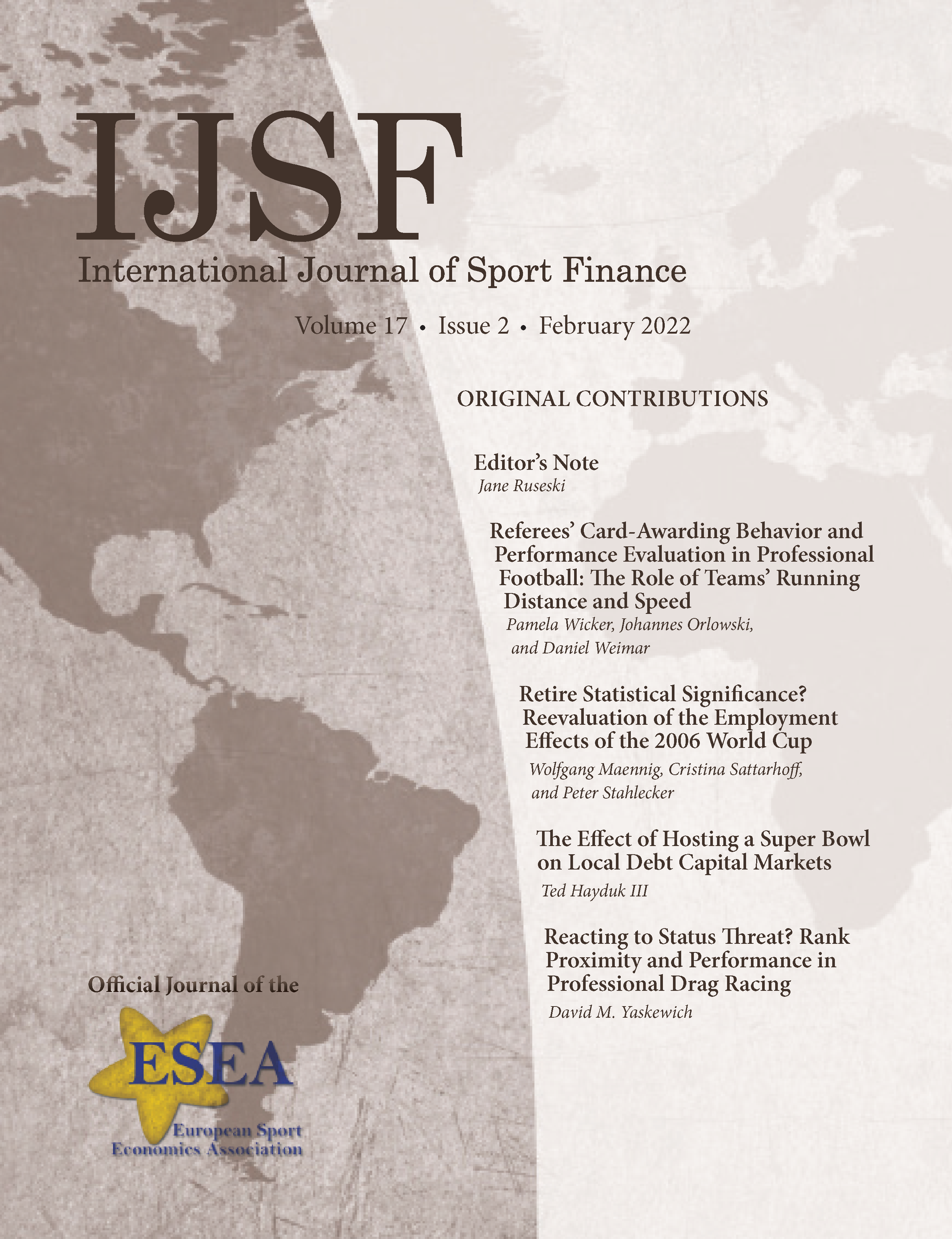International Journal of Sport Finance
Issue 17:2 – May, 2022
Issue 17:2 – May, 2022

Pamela Wicker, Johannes Orlowski, and Daniel Weimar
This study examines the effect of football teams’ distance covered and number of intensive runs (>20 km/h) on referees’ card-awarding behavior and their performance evaluation. The empirical analysis uses data from the German Bundesliga (2011–2018), yielding a final sample of n = 2,130 observations on a match-game day basis. Card-awarding behavior is measured with the number of yellow, yellow-red, and red cards awarded. Performance evaluation is captured by Kicker grades. The regression analyses show that greater distance covered by teams is associated with significantly fewer yellow, yellow-red, and red cards and significantly better grades for referees. The higher the number of intensive runs, the fewer yellow-red and red cards are awarded. Referees receive significantly better grades when teams have covered more distance in the match. Collectively, these findings suggest that not only referees make biased decisions but that the evaluation of their performance is also subject to biases.
Wolfgang Maennig, Cristina Sattarhoff, and Peter Stahlecker
Almost all econometric analyses of mega sporting events show nonsignificant results, i.e., they fail to reject the null hypothesis at the usual α levels of significance. Our contribution takes up the recent critique against the usual handling of the term of significance and qualifies the common interpretation that from a statistical point of view, the effects of mega sporting events are not significant. For this purpose, we use employment data from the World Cup 2006 in Germany. We determine empirical power functions of the relevant t-tests by means of a simulation study with autocorrelated and heteroscedastic error terms. In addition, we consider equivalence tests. Despite the relatively large goodness of fit of the model, it is not possible to reject the hypothesis of zero employment effects of the World Cup. At the same time, our simulation experiments show that even a fundamental raise/decline in unemployment in the World Cup venues of 6 to 7 percentage points would not be recognized in 50% of all cases.
Ted Hayduk III
Proponents of the Super Bowl claim beneficial ‘development’ effects of hosting the game on local businesses. Thus, one might expect to see corresponding adjustments in the local market for debt capital—the predominant source of business creation and reinvestment—around the time of the Super Bowl. Leveraging a panel dataset of 165 local lenders headquartered in 13 Super Bowl host cities between 1971 and 2011, the analysis finds no consistent trends in the volume of debt capital lent or lenders’ external risk exposure. Somewhat consistent trends were documented for lenders’ internal risk structure and financial performance. Results also suggest that in cities that host the Super Bowl regularly, there are lending contractions around the time of the game, which are followed by reactionary expansions after the game.
David M. Yaskewich
This paper used data from professional drag racing to study how proximity to another competitor in a status ranking affected performance. The one-on-one format of races in National Hot Rod Association (NHRA) tournaments provided a setting to analyze pairs of higher- and lower-ranked drivers when status differentials were either large or small. Based on panel data from the 2009 through 2019 seasons of the NHRA’s Top Fuel and Funny Car divisions, results indicated that rank proximity improved absolute performance on reaction times by higher-ranked drivers. However, this effect only occurred when contiguously ranked opponents were paired together. Lower-ranked drivers, or underdogs, did not experience any improvements in absolute performance due to rank proximity. In the main findings, I observed that a threat of status loss can motivate performance for a focal competitor, but this effect primarily occurred when a status rival was physically present during a task.